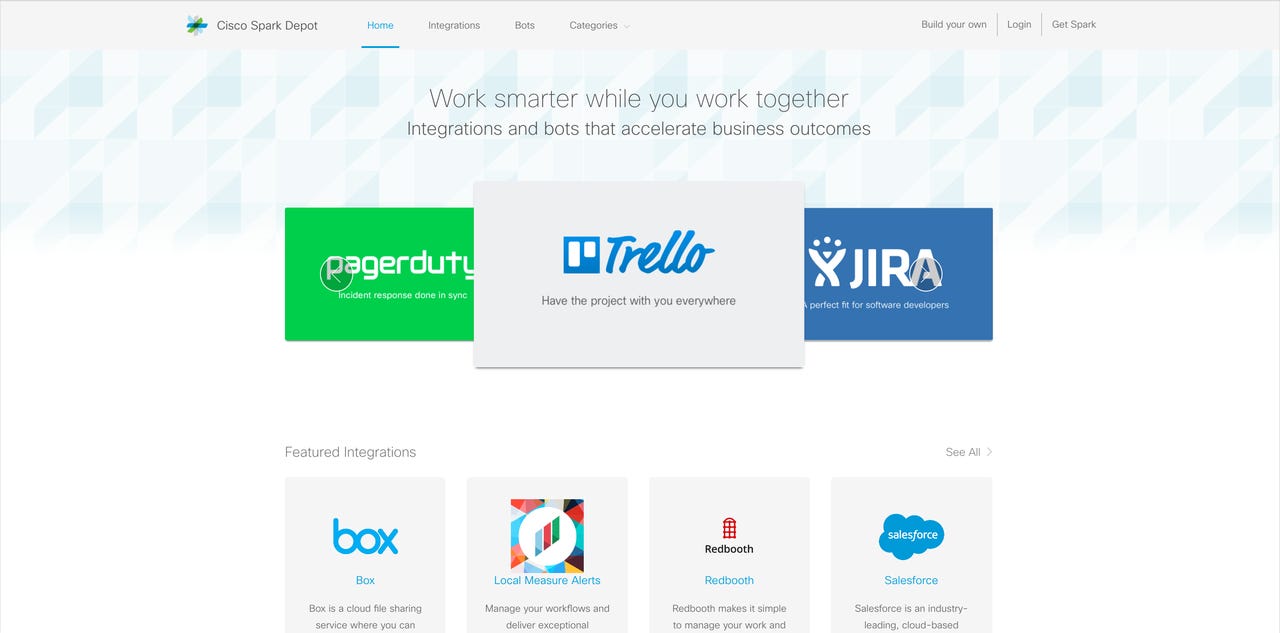Cisco rolls out new collaboration tools


The Cisco Spark Depot is a hub where users can find different applications integrated with the Spark platform. With its launch, the Depot will have around 70 standard integrations.
Cisco on Tuesday rolled out a series of new collaboration tools, designed to help customers get more value out of the cloud while still leveraging on-premise deployments.
The new offerings, coming as the market for enterprise collaboration tools becomes increasingly competitive, are largely designed with the intent of keeping Cisco's base of legacy customers happy with their investments.
The new tools include the Spark Depot, which is effectively an app store for Spark, and the Spark Flex Plan, which lets customers choose a mix of on-premise and cloud-based services that they can recalibrate at any time. Cisco is also rolling out its Spark Hybrid Media Service, which can automatically tap into the cloud when local media resources are spent. Lastly, Cisco is updating its Business Edition telephony options, with an enhanced, cloud-managed version of its enterprise offering (Business Edition 6000) and a new SMB offering (Business Edition 4000).
"Transitioning to the cloud is critical for companies large and small," wrote Rowan Trollope, GM of Cisco's IoT and Applications groups, in a blog post. "But not every company is ready to move everyone and everything to the cloud today. We want customers to transition to the cloud when and how it makes sense."
To accommodate those customers, Cisco is offering the Spark Flex Plan. It puts customers on a per-month subscription-based payment plan, giving them room to adjust how much they're relying on the cloud. Under a single contract, a customer can choose a mix of cloud, on-premise services or a little of both -- the price stays the same if the combination is adjusted.
It's especially suited for legacy customers who've already made large investments in on-premise services. If a customer has already invested in an on-premise service like videoconferencing, they can add other cloud-based services and wrap it all into an ongoing subscription purchase model, receiving credit for what they've already paid.
The new Cisco Spark Hybrid Media Service also allows for some flexibility in cloud deployment. At no extra cost, customers have the option to deploy Cisco Spark meetings on premises, in the cloud or both at the same time. The service then automatically determines the best way to deliver the meeting for each user -- from the premises if users are local or from the cloud if not. After local resources are tapped, new participants are added via the cloud, allowing for unlimited number of people to join a meeting.
The service also improves user audio and video quality, keeps media on-premises for privacy, and lowers internet bandwidth costs by eliminating media hair-pinning to the cloud.
Meanwhile, the Spark Depot is a hub where users can find different applications that have been integrated with the Spark platform. The development comes about a year after Cisco introduced Spark for Developers.
With its launch, the Depot will have around 70 standard integrations, including ones developed by Cisco and ones developed by third parties. Third parties can submit their integrations to the Depot, where there will be some validation before they're exposed to customers.
Lastly, Cisco is updating its telephony services, starting with an entirely new offering for small businesses. Available in the coming months, the Business Edition 4000 will offer voice service and voice mail for up to 200 devices. There's a box that sits on site, and its ongoing management is handled through a cloud-hosted interface. The service takes less than a day to install and configure.
If a company grows, it can upgrade to the BE 6000 offering, which also has an improved configuration and installation process. Now, the system can largely be set up through a cloud management portal rather than on site, reducing installation times by up to 60 percent.